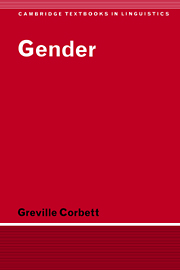Book contents
- Frontmatter
- Contents
- List of figures
- List of tables
- Preface
- List of abbreviations
- 1 INTRODUCTION
- 2 GENDER ASSIGNMENT I: SEMANTIC SYSTEMS
- 3 GENDER ASSIGNMENT II: FORMAL SYSTEMS
- 4 THE PSYCHOLINGUISTIC STATUS OF GENDER ASSIGNMENT
- 5 GENDER AGREEMENT
- 6 ESTABLISHING THE NUMBER OF GENDERS
- 7 TARGET GENDERS: SYNCRETISM AND ENFORCED GENDER FORMS
- 8 HYBRID NOUNS AND THE AGREEMENT HIERARCHY
- 9 GENDER RESOLUTION RULES
- 10 GENERALIZATIONS AND PROSPECTS
- References
- Author index
- Language index
- Subject index
- Frontmatter
- Contents
- List of figures
- List of tables
- Preface
- List of abbreviations
- 1 INTRODUCTION
- 2 GENDER ASSIGNMENT I: SEMANTIC SYSTEMS
- 3 GENDER ASSIGNMENT II: FORMAL SYSTEMS
- 4 THE PSYCHOLINGUISTIC STATUS OF GENDER ASSIGNMENT
- 5 GENDER AGREEMENT
- 6 ESTABLISHING THE NUMBER OF GENDERS
- 7 TARGET GENDERS: SYNCRETISM AND ENFORCED GENDER FORMS
- 8 HYBRID NOUNS AND THE AGREEMENT HIERARCHY
- 9 GENDER RESOLUTION RULES
- 10 GENERALIZATIONS AND PROSPECTS
- References
- Author index
- Language index
- Subject index
Summary
Gender is the most puzzling of the grammatical categories. It is a topic which interests non-linguists as well as linguists and it becomes more fascinating the more it is investigated. In some languages gender is central and pervasive, while in others it is totally absent. One of its attractions for linguists is that there are interesting aspects of the study of gender in each of the core areas of linguistics. And work on it promises practical benefits, even in the short term, in meeting the problems which gender causes in second-language learning. In the longer term, research into gender will be important for at least two other areas: first, it can shed light on the way in which linguistic information is stored in the brain; and second, it has implications for natural language processing, notably for the elimination of local ambiguities in parsing. To understand what linguists mean by ‘gender’, a good starting point is Hockett's definition: ‘Genders are classes of nouns reflected in the behavior of associated words’ (1958: 231). A language may have two or more such classes or genders. The classification frequently corresponds to a real-world distinction of sex, at least in part, but often too it does not (‘gender’ derives etymologically from Latin genus, via Old French gendre, and originally meant ‘kind’ or ‘sort’). The word ‘gender’ is used not just for a group of nouns but also for the whole category; thus we may say that a particular language has, say, three genders, masculine, feminine and neuter, and that the language has the category of gender.
- Type
- Chapter
- Information
- Gender , pp. 1 - 6Publisher: Cambridge University PressPrint publication year: 1991
- 1
- Cited by



